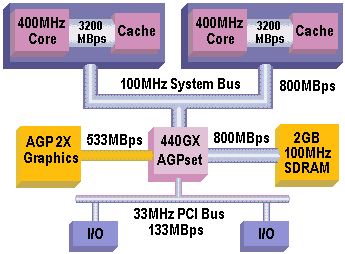The Intel 440 series of chipsets built on the Pentium’s success to advance Intel dominance.
440LX
The 440LX (by this time Intel had dropped the term Triton) was the successor to the Pentium Pro 440FX chipset and was developed by Intel to consolidate on the critical success of the Pentium II processor launched a few months earlier. The most important feature of the 440LX is support for the Accelerated Graphics Port (AGP), a new, fast, dedicated bus designed to eliminate bottlenecks between the CPU, graphics controller and system memory, which will aid fast, high-quality 3D graphics.
Other improvements with the LX are more like housekeeping, bringing the Pentium II chipset up to the feature set of the 430TX by providing support for SDRAM and Ultra DMA IDE channels. The chipset includes the Advanced Configuration and Power Interface (ACPI), allowing quick power down and up, remote start-up over a LAN for remote network management, plus temperature and fan speed sensors. The chipset also has better integration with the capabilities of the Pentium II, such as support for dynamic execution and processor pipelining.
440EX
The 440EX AGPset, based on the core technology of the 440LX AGPset, is designed for use with the Celeron family of processors. It is ACPI-compliant and extends support for a number of advanced features such as AGP, UltraDMA/33, USB and 66MHz SDRAM, to the Basic PC market segment.
440BX
The PC’s system bus had been a bottleneck for too long. Manufacturers of alternative motherboard chipsets had made the first move, pushing Socket 7 chipsets beyond Intel’s 66MHz. Intel’s response came in April 1998, with the release of its 440BX chipset, which represented a major step in the Pentium II architecture. The principal advantage of the 440BX chipset is support for a 100MHz system bus and 100MHz SDRAM. The former 66MHz bus speed is supported, allowing the BX chipset to be used with older (233MHz-333MHz) Pentium IIs.
The 440BX chipset features Intel’s Quad Port Acceleration (QPA) to improve bandwidth between the Pentium II processor, the Accelerated Graphics Port, 100-MHz SDRAM and the PCI bus. QPA combines enhanced bus arbitration, deeper buffers, open-page memory architecture and ECC memory control to improve system performance. Other features include support for dual processors, 2x AGP, and the Advanced Configuration Interface (ACPI).
440ZX
The 440ZX is designed for lower cost form factors without sacrificing the performance expected from an AGPset, enabling 100MHz performance in form factors like microATX. With footprint compatibility with the 440BX, the 440ZX is intended to allow OEMs to leverage BX design and validation investment to produce new systems to meet entry level market segment needs.
440GX
Released at the same time as the Pentium II Xeon processor in mid-1998, the 440GX chipset was an evolution of the 440BX AGPset intended for use with Xeon-based workstations and servers. Built around the core architecture of its 440BX predecessor, the 440GX includes support for both Slot 1 and Slot 2 implementations, a 2x AGP expansion slot, dual CPUs and a maximum of 2GB of memory.

Importantly, the chipset supports full speed backside bus operation, enabling the Pentium II Xeon’s Level 2 cache to run at the same speed as the core of the CPU.
- Intel’s Triton Chipsets Explained – their history, architecture and development
- Intel 440 Chipsets – 440LX, 440EX, 440BX, 440ZX, 440GX
- i810 Chipset
- Intel 820 Chipset
- i815 Chipsets
- i850 Chipsets
- i845 Chipset
- What is the Intel E7205 Chipset? What Features Does it Have?
- i875P Chipset
- i865 Chipsets
- What is Intel’s 925X PCI Express Chipset
- i915 Chipset
- i945 Chipset
- Intel’s 955X Express Chipset – Glenwood
- i965 Chipset
- A Comparison Chart of Intel’s Chipsets from 915P to P965